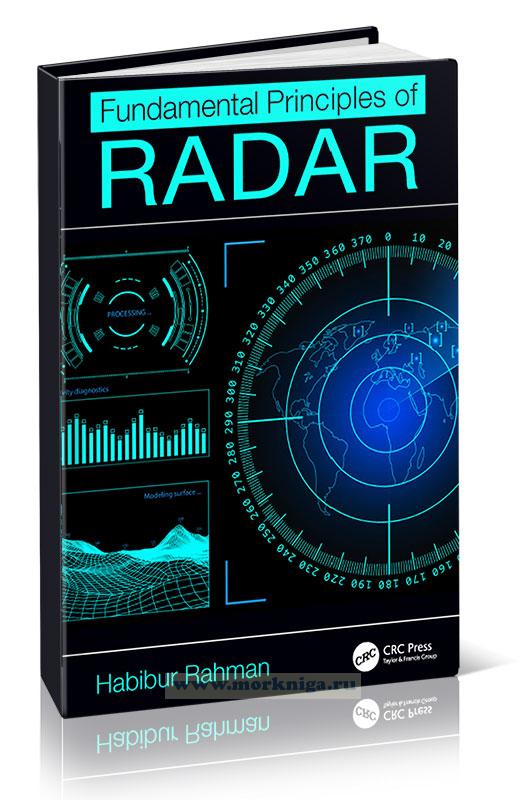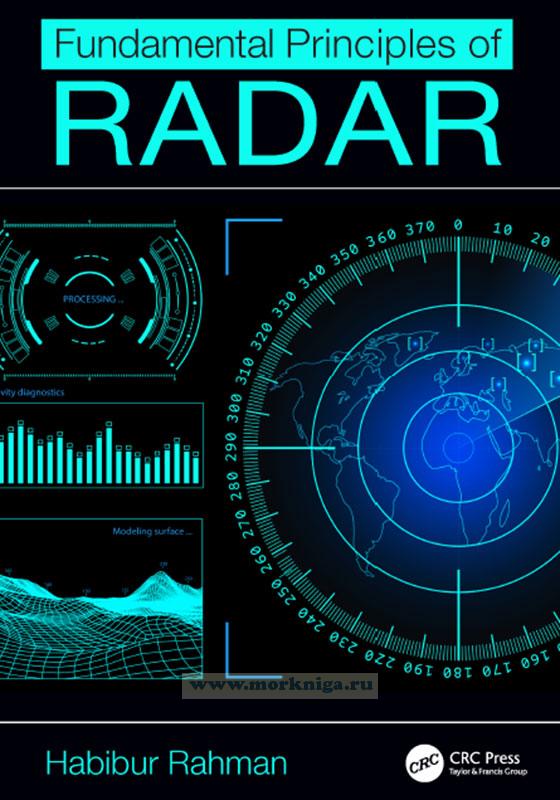Fundamental Principles of Radar/Основные принципы радара
Издание на английском языке
The important and fascinating topics of radar enjoy an extensive audience in industry and government, but they deserve more attention in undergraduate education to better prepare graduating engineers to meet the demands of modern mankind. Radar is not only one of the major applications of electronics and electromagnetic communications but also a mature scientific discipline with significant theoretical and mathematical foundations that may warrant an intellectual and educational challenge specifically in a classroom environment. Although there is a plethora of books on radar systems, all of them are written for the specialist or the advanced graduate students covering the subject of radar in varying degrees of detail and scope. Most of the existing books do not provide end-of-chapter problems to help students exercise the concepts developed, and cover a wider scope of topics usually not suitable for readers seeking an initial exposure to radar.
This book is an attempt to serve as a textbook for a course providing the first exposure to radar principles. It provides a broad concept underlying the basic principle of operations of most of the existing radar systems, and maintains a good balance of mathematical rigor suitable enough to convince readers without causing them to lose interest. The purpose of the book is to provide an extensive exposition of techniques currently being used for radar system design, analysis, and evaluation. It presents a comprehensive set of radar principles-including all features of modern radar applications-with their underlying derivations using the simplest mathematics possible.
The coverage is limited basically to the main concepts of radar with an attempt to present them in a systematic and organized fashion. Topics are treated not as abstruse and esoteric to the point of incomprehensibility. Highly specialized topics that cover a wider scope with less detail are not chosen. Every attempt is made to distill the very complex and rich technology of radar into its fundamentals. Emphasis is given on clarity without sacrificing rigor and completeness. Abundant examples and exercises are chosen to reinforce the concepts presented, and to illustrate the radar applications. Hundreds of notes and references are provided leading to further reading and discussion of subtle and interesting concepts and applications. These notes and references provide an unusual degree of completeness for a textbook at this level, with interesting and sometimes thought-provoking content to make the subject even more appealing.
Fundamental Principles of Radar is designed for upper-division undergraduate and junior graduate engineering students, for those seeking their first exposure to radar principles through self-study, and for practicing radar engineers who need an in-house up-to-date reference text. The student using the text is assumed to have completed typical lower-division physics and mathematics. Some exposures to electromagnetic communications and probability theory are also useful.
The entire book can be covered leisurely in two semesters. However, most of the material, with the exclusion of some chapters, can be squeezed into one semester. The material covered in the book is broad enough to satisfy a variety of backgrounds and interests, thereby allowing considerable flexibility in making up the course material.
Contents
Preface
Author
Chapter 1 Introduction
1.1 Historical Notes
1.2 Elementary Electromagnetic Waves
1.3 Radar Principles
1.4 Basic Radar Block Diagram and Operation
1.5 Basic Elements of Radar System
1.6 Types of Radar Systems
Notes and References
Chapter 2 Radar Fundamentals
2.1 Introduction
2.2 Detection
2.3 Range
2.4 Velocity Measurement
2.5 Target Location Measurement
2.6 Signature Reflectivity and Imaging
Problems
Chapter 3 Radar Equations
3.1 The Radar Equations: An Introduction
3.2 The Pulse Radar Equation
3.3 The Search Radar Equation
3.4 The Tracking Radar Equation
3.5 The Bistatic Radar Equation
3.6 The Radar Equation with Pulse Compression
3.7 Radar Equation with Jamming
3.8 The Beacon Radar Equation
Problems
Chapter 4 Targets and Interference
4.1 Introduction
4.2 Radar Cross Section (RCS)
4.3 RCS Fluctuations and Statistical Models
4.4 Radar Clutter
4.5 Clutter Statistical Distributions
4.6 Clutter Spectrum
4.7 Radar Receiver Noise
4.8 System Losses
Problems
References
Chapter 5 Propagation of Radar Waves
5.1 Introduction
5.2 Reflection Effects due to Multipath Phenomena
5.3 Refraction of EM Waves
5.4 Diffraction of EM Wave
5.5 Attenuation by Atmospheric Gases
5.6 Ionospheric Attenuation
Problems
References
Chapter 6 Continuous Wave (CW) Radars
6.1 Introduction
6.2 Unmodulated Continuous Wave (CW) Radar
6.3 Frequency Modulated CW Radars
6.4 Multiple-Frequency CW Radar
6.5 Phase-Modulated CW Radar
Problems
References
Chapter 7 MTI and Pulse Doppler Radars
7.1 Introduction
7.2 Description of Operation
7.3 Single Delay-Line Canceler
7.4 Double Delay-Line Canceler
7.5 MTI Recursive Filter
7.6 MTI Nonrecursive Filter
7.7 Staggered Pulse Repetition Frequencies
7.8 Pulse Doppler Radar
7.9 Range and Doppler Ambiguities
Problems
References
Chapter 8 Pulse Compression Radar
8.1 Introduction
8.2 The Matched Filter
8.3 The Radar Ambiguity Function
8.4 Pulse Compression in Radars
8.5 Frequency Modulation in Pulse Compression
8.6 Phase-Coded Modulation in Pulse Compression
Problems
References
Chapter 9 Synthetic Aperture Radars
9.1 Introduction
9.2 SAR History
9.3 SAR General Description
9.4 SAR Signal Processing
9.5 Radar Equation of the SAR System
9.6 SAR System Design Consideration
Problems
References
Chapter 10 Tracking Radars
10.1 Introduction
10.2 Range Tracking
10.3 Angle Tracking
10.4 Track-While-Scan (TWS) Radar
Problems
References
Chapter 11 Aperture and Phased Array Antennas
11.1 Introduction
11.2 Fundamental Antenna Parameters
11.3 Aperture Antennas
11.4 Phased Array Antennas
Problems
References
Chapter 12 Radar Height Finder and Altimeter
12.1 Introduction
12.2 Derivation of Radar Heights
12.3 Height-Finding Radars
12.4 Radar Altimeters
References
Chapter 13 Radar Electronic Warfare
13.1 Introduction
13.2 Historical Backgrounds
13.3 Electronic Warfare Definitions
13.4 Effects of EW Elements
13.5 Electronic Support Measures (ESM)
13.6 Electronic Countermeasures (ECM)
13.7 Electronic Counter-Countermeasures (ECCM)
References
Chapter 14 Over-the-Horizon Radar
14.1 Introduction
14.2 Historical Notes
14.3 Classification of OTHR Systems
14.4 Ionospheric Effects on the OTHR System
14.5 Ray Path Trajectories
14.6 Principles of OTHR Systems
14.7 Current OTHR Systems in Use
References
Chapter 15 Secondary Surveillance Radar
15.1 Introduction
15.2 Principles of SSR
15.3 Deficiencies in SSR
15.4 Solutions to SSR Deficiencies
15.5 Range Performance in SSR
References
Appendixes
Appendix A: Review of Deterministic Signals
Appendix B: Review of Random Signals
Appendix C: Z-Transforms Table
Appendix D: Fourier Transforms Table
Appendix E: Probability Density Functions
Appendix F: Mathematical Formulas
References
Answers to Selected Problems
Bibliography
Index

